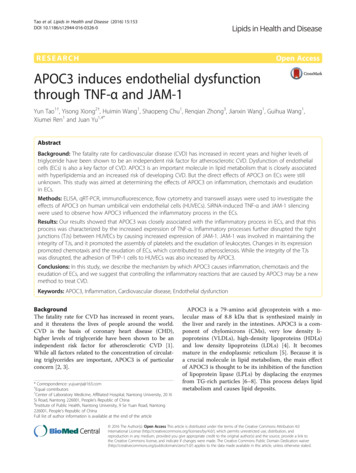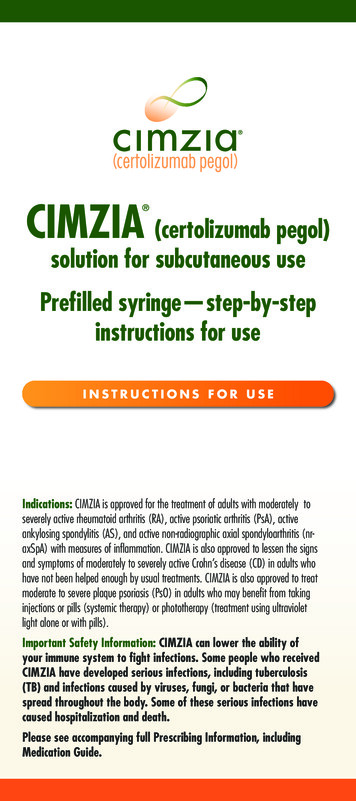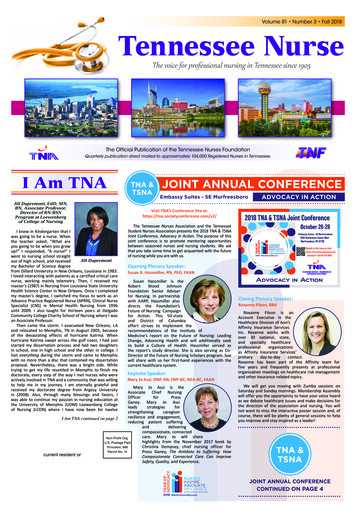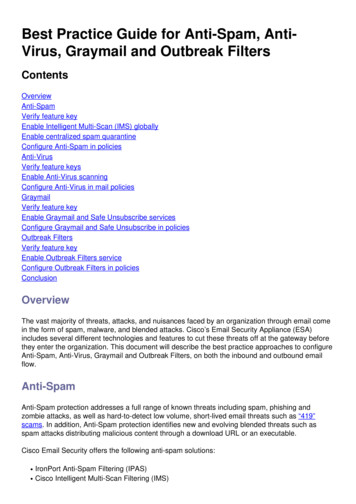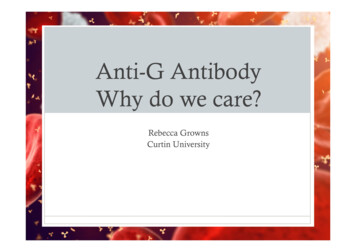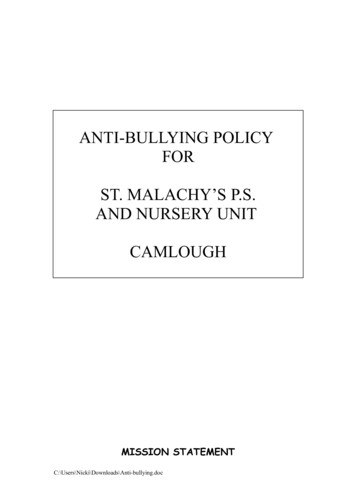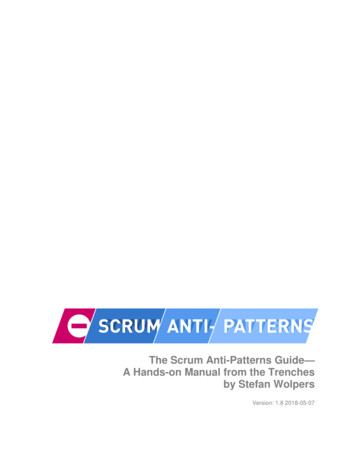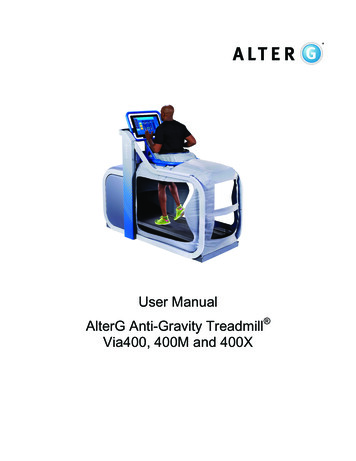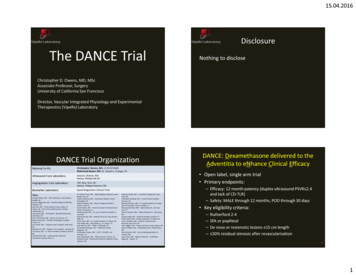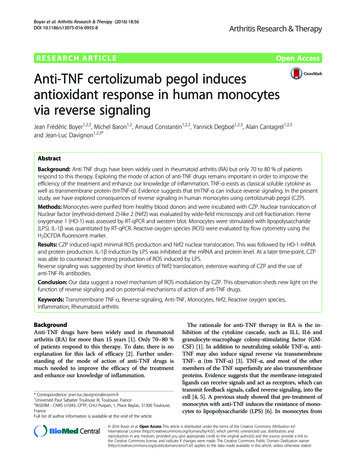
Transcription
Boyer et al. Arthritis Research & Therapy (2016) 18:56DOI 10.1186/s13075-016-0955-8RESEARCH ARTICLEOpen AccessAnti-TNF certolizumab pegol inducesantioxidant response in human monocytesvia reverse signalingJean Frédéric Boyer1,2,3, Michel Baron1,2, Arnaud Constantin1,2,3, Yannick Degboé1,2,3, Alain Cantagrel1,2,3and Jean-Luc Davignon1,2,3*AbstractBackground: Anti TNF drugs have been widely used in rheumatoid arthritis (RA) but only 70 to 80 % of patientsrespond to this therapy. Exploring the mode of action of anti-TNF drugs remains important in order to improve theefficiency of the treatment and enhance our knowledge of inflammation. TNF-α exists as classical soluble cytokine aswell as transmembrane protein (tmTNF-α). Evidence suggests that tmTNF-α can induce reverse signaling. In the presentstudy, we have explored consequences of reverse signaling in human monocytes using certolizumab pegol (CZP).Methods: Monocytes were purified from healthy blood donors and were incubated with CZP. Nuclear translocation ofNuclear factor (erythroid-derived 2)-like 2 (Nrf2) was evaluated by wide-field microscopy and cell fractionation. Hemeoxygenase 1 (HO-1) was assessed by RT-qPCR and western blot. Monocytes were stimulated with lipopolysaccharide(LPS). IL-1β was quantitated by RT-qPCR. Reactive oxygen species (ROS) were evaluated by flow cytometry using theH2DCFDA fluorescent marker.Results: CZP induced rapid minimal ROS production and Nrf2 nuclear translocation. This was followed by HO-1 mRNAand protein production. IL-1β induction by LPS was inhibited at the mRNA and protein level. At a later time-point, CZPwas able to counteract the strong production of ROS induced by LPS.Reverse signaling was suggested by short kinetics of Nrf2 translocation, extensive washing of CZP and the use ofanti-TNF-Rs antibodies.Conclusion: Our data suggest a novel mechanism of ROS modulation by CZP. This observation sheds new light on thefunction of reverse signaling and on potential mechanisms of action of anti-TNF drugs.Keywords: Transmembrane TNF-α, Reverse signaling, Anti-TNF, Monocytes, Nrf2, Reactive oxygen species,Inflammation, Rheumatoid arthritisBackgroundAnti-TNF drugs have been widely used in rheumatoidarthritis (RA) for more than 15 years [1]. Only 70–80 %of patients respond to this therapy. To date, there is noexplanation for this lack of efficacy [2]. Further understanding of the mode of action of anti-TNF drugs ismuch needed to improve the efficacy of the treatmentand enhance our knowledge of inflammation.* Correspondence: jean-luc.davignon@inserm.fr1Université Paul Sabatier Toulouse III, Toulouse, France2INSERM - CNRS U1043, CPTP, CHU Purpan, 1, Place Baylac, 31300 Toulouse,FranceFull list of author information is available at the end of the articleThe rationale for anti-TNF therapy in RA is the inhibition of the cytokine cascade, such as IL1, IL6 andgranulocyte-macrophage colony-stimulating factor (GMCSF) [1]. In addition to neutralizing soluble TNF-α, antiTNF may also induce signal reverse via transmembraneTNF- α (tm TNF-α) [3]. TNF-α, and most of the othermembers of the TNF superfamily are also transmembraneproteins. Evidence suggests that the membrane-integratedligands can receive signals and act as receptors, which cantransmit feedback signals, called reverse signaling, into thecell [4, 5]. A previous study showed that pre-treatment ofmonocytes with anti-TNF induces the resistance of monocytes to lipopolysaccharide (LPS) [6]. In monocytes from 2016 Boyer et al. Open Access This article is distributed under the terms of the Creative Commons Attribution 4.0International License (http://creativecommons.org/licenses/by/4.0/), which permits unrestricted use, distribution, andreproduction in any medium, provided you give appropriate credit to the original author(s) and the source, provide a link tothe Creative Commons license, and indicate if changes were made. The Creative Commons Public Domain Dedication o/1.0/) applies to the data made available in this article, unless otherwise stated.
Boyer et al. Arthritis Research & Therapy (2016) 18:56patients with RA, anti-TNF stimulation was shown todecrease the secretion of inflammatory cytokine andto induce apoptosis [7]. These observations were attributed to reverse signaling. The role of reverse signaling in the initiation and perpetuation of arthritis isnot established.Monocytes are attractive targets for the treatment of RA[8]. Our laboratory is interested in the characterization ofthe role of tm-TNF-α in monocytes as a possible cell target of anti-TNF, which is now commonly used in the treatment of RA. In a previous study, we investigated the roleof TNF-α and adalimumab on CD36 expression in humanmonocytes. F(ab’)2 fragment obtained from adalimumabinduced an increase in CD36 expression due to reversesignaling depending on reactive oxygen species (ROS) [9].As nuclear factor (erythroid-derived 2)-like 2 (Nrf2) is induced upon ROS production [10–14] and is involved inCD36 induction [15, 16], we hypothesized that it could beinduced by anti-TNF. Nrf2 is a redox-sensitive basic leucine zipper transcription factor involved in the transcriptional regulation of many antioxidant and cell protectivegenes. It plays a role in the control of inflammation. Forexample, genetic disruption of Nrf2 in different mousemodels increases the mortality of mice in response to septic shock, increases the severity of arthritis, and leads tosevere allergen-driven airway inflammation and hyperresponsiveness [17, 18].HO-1 is an enzyme regulated by Nrf2 [19]. In inflammation, heme oxygenase 1 (HO-1) protects cells from oxidative damage during stress [20]. In a model of geneticinactivation of HO-1, mice are vulnerable to mortality andhepatic necrosis when challenged with endotoxin [21]. Ina human case of HO-1 deficiency the patient presentedwith growth retardation, anemia, iron deposition, and vulnerability to stressful injury [22]. Endothelial cells frommice with HO-1 knockout (KO) have enhanced sensitivityto complement [23]. Anti-inflammatory effects of HO-1usually result from the degradation of pro-inflammatoryfree heme, and the production of the anti-inflammatorycompounds as carbon monoxide (CO), biliverdin/bilirubinand free iron [24]. HO-1 could thus be a therapeutictarget in RA.In this work we thus used certolizumab pegol (CZP)to investigate the induction of Nrf2 through tmTNF-α.CZP was chosen because it is a monovalent Fab antiTNF antibody linked with a polyethylene glycol (PEG)fragment that has no Fc fragment [7, 25]. We showedthat CZP induced rapid ROS induction and nucleartranslocation of Nrf2 and expression of HO-1. Moreover,LPS-induced ROS expression and IL-1 production wereattenuated by CZP, suggesting an effect on toll-like receptor (TLR)4-induced inflammation. Our data point toa mechanism, which, due to reverse signaling, may regulate inflammation.Page 2 of 9MethodsReagentsLPS from Eschericia coli 055:B5 was purchased fromSigma (St Louis, MO, USA). Nrf2 (H300) antibodieswere purchased from Santa Cruz Biotechnology (Dallas,TX, USA), anti-rabbit IgG horse radish peroxidase(HRP)-linked antibodies, Alexa Fluor 488 F(ab’)2 antirabbit IgG, tatabox binding protein (TBP) and HO-1(P249) antibodies were purchased from Cell SignalingTechnology (Danvers, MA, USA) and glyceraldehyde 3phosphate dehydrogenase (GAPDH) (ABS16) antibodieswere purchased from Millipore (Temecula, CA, USA).Blocking antibodies against TNF receptor 1 (TNFR1)(clone #16805) and TNFR2 (clone #22210) were purchased from R&D Systems (Minneapolis, MN, USA).Anti-CD14 (HCD14) antibody was from Biolegend, SanDiego, CA, USA. H2DCFDA (C-2938) was purchasedfrom Life Technologies (Carlsbad, CA, USA). The 4',6diamidino-2-phenylindole (DAPI) was purchased fromBiolegend (San Diego, CA, USA). The diphenyleneiodonium chloride (DPI) and wortmannin inhibitors werepurchased from Sigma.Preparation of peripheral blood mononuclear cells(PBMC) and monocyte purificationPBMC were isolated from healthy blood donors (Etablissement Français du Sang Transfusion Center, Toulouse,France). Ethical approval was obtained from the Transfusion Center. Informed consent was obtained from blooddonors. PBMC were separated by ficoll density gradientcentrifugation at 700 g for 20 minutes. They were then resuspended in PBS 2 mM ethylenediaminetetraacetic acid(EDTA) and thoroughly washed (centrifugation at 350 gfor 8 minutes six times). The percentage of monocyteswas evaluated by flow cytometry on a FACSCalibur cytometer (BD Bioscience, San Diego, CA, USA) with ananti-CD14 (HCD14) antibody (Biolegend, San Diego, CA,USA)). CD14 monocytes were purified by negativeimmunomagnetic bead separation using DynabeadsUntouched Human Monocytes kit (Life Technologies,Carlsbad, CA, USA). Purity of CD14 monocyteswas 90 %. Monocytes were then incubated in Macrophage SFM medium (Life Technologies) and plated onehour before applying any treatment. Cells were incubatedwith CZP (5 μg/ml) for the indicated times, then thoroughly washed as described [6, 25].Quantitative real-time PCRTotal RNA from 4 106 monocytes was isolated usingHigh Pure RNA Isolation Kit (Roche Diagnostics GmbH,Mannheim, Germany) and complementary DNA (cDNA)synthesized with RevertAid Minus Reverse Transcriptase(Thermo Fisher Scientific, Waltham, MA, USA). Geneexpression was performed using LightCycler 480 SYBR
Boyer et al. Arthritis Research & Therapy (2016) 18:56Green Master Mix and LightCycler 480 System instrument(Roche Diagnostics GmbH). All primers were designedusing ProbeFinder Software (Roche Applied Sciencewebsite), and synthetized by Sigma Life Science (St QuentinFallavier, France) (Table 1).ROS measurementsFor intracellular ROS measurement, we used theH2DCFDA compound. Monocytes (4 105 cells) weregrown in a 24 well-plate in 0.5 ml Macrophage SFMmedium. All treatment conditions were performed induplicate. Monocytes were incubated, or not, for 5, 15and 30 minutes with 5 μg/ml of CZP. Then, culturemedium was discarded and replaced by PBS containing2 μM H2DCFDA. Monocytes were incubated for 30 minutes and then detached from the well in 300 μl of PBS5 mM EDTA at 4 C. The level of fluorescence (geometric mean) was measured by flow cytometry on a FACSCalibur cytometer.In another experiment, monocytes were incubated, ornot, for 1 h with 5 μg/ml of CZP, washed three timeswith medium to remove unfixed CZP, and then incubated for 18 h in medium containing LPS. The ROS production was then measured. All cytometry data wereanalyzed by FlowJo (TreeStar Inc, Ashland, OR, USA).Western blot analysisTotal extracts from 4 106 monocytes lysed in 50 μl ofLaemmli buffer were denatured at 95 C for 10 minutesand sonicated: 15–20 μl were run on Novex NuPAGE4–12 % Bis-Tris mini gels and transferred on nitrocellulosemembrane with X-Cell blot module (Life Technologies).After incubation with primary and secondary HRPcoupled antibodies, labeled proteins were visualizedby enhanced chemiluminescence with ECL PrimeWestern Blotting Detection Reagent (GE Healthcare,Piscataway, NJ, USA) on a ChemiDoc XRS imagingsystem (Bio-Rad Laboratories, Hercules, CA, USA).All images were analyzed with the Image Lab 5.0software (Bio-Rad). Antibodies to GAPDH and TBPwere used to normalize the loading quantities of protein in the different lanes of the gels.Preparation of nuclear extractsMonocytes (4–5 106) grown in 6-well plates and 2 mlof Macrophage SFM medium were scraped in 1 ml ofTable 1 Primers sequences used for qPCRGeneAccessionnumbergapdh J04038.1hmox1 NM 002133.2IL1BNM 000576.2Forward primerReverse gagggtgatagaagagg gaacaccacttgPage 3 of 9ice-cold PBS supplemented by protease inhibitor cocktail(PIC, P8340, Sigma) at 1:100 dilution and harvested at800 g and 4 C for 4 minutes. Cells were resuspended in50 μl of lysis buffer (10 mM TRIS pH 7.3, 1 mM MgCl2,250 mM sucrose, 0.25 % NP40, 1:50 PIC) and left on icefor 10 minutes. After centrifugation at 1500 g for 4 minutes at 4 C, the nuclear enriched pellet was lysed in50 μl of Laemmli buffer. The lysates were denatured for8 minutes at 95 C and sonicated before western blotanalysis.Immunofluorescence microscopyMonocytes (3 105 cells) in 0.5 ml of Macrophage SFMmedium were plated for 1 h on a glass coverslip in a 24well plate and incubated, or not, by 5 μg/ml CZP. After30 minutes, the medium was removed by aspiration andcells were fixed and permeabilized with 250 μl methanolat 80 % over 4 minutes at –20 C. After washing withPBS and PBS 0.25 % BSA, cells were incubated with theNrf2 (H300) antibody at 1:250 dilution for 1 h. Cellswere rinsed three times with PBS-BSA and then incubated with secondary anti-rabbit AF488 antibody for another 1 h. DAPI at a final concentration of 0.3 μM wasadded for 10 minutes and cells were washed anotherthree times with PBS-BSA. The coverslip glass wasmounted on a microscopic slide with Mowiol mountingmedium. All observations were made on an ApotomeZeiss device equipped with a 63 objective. Images wereobtained using Zen software (Carl Zeiss MicroscopyGmbH, Jena, Germany).StatisticsAll experiments were performed more than three times.The values are expressed as the mean standard deviation (SD). The t test was used to assess the significanceof differences between two conditions. All p values aretwo-sided, and p values equal to or below 0.05 were considered significant.ResultsAnti-TNF induces ROS production and nucleartranslocation of Nrf2 translocation in human monocytesIn a previous report, we observed that the increase inCD36 expression induced by the anti-TNF agent adalimumab was dependent on nicotinamide adenine dinucleotide phosphate-oxidase (NADPH) activation [9].We showed that CZP induces cytoplasmic ROS production shortly after incubation (within 5–30 minutes) withmonocytes (Fig. 1a). As Nrf2 is involved in the responseto ROS and is involved in the regulation of CD36 expression [16], we assessed its nuclear translocation inmonocytes. As shown in Fig. 1b, the anti-TNF CZP induced the nuclear translocation of Nrf2. Nuclear translocation was also confirmed by western blot of cellular
Boyer et al. Arthritis Research & Therapy (2016) 18:56Page 4 of 9Fig. 1 Certolizumab pegol (CZP) induces rapid production of reactive oxygen species (ROS) and nuclear translocation of nuclear factor (erythroidderived 2)-like (Nrf2). Monocytes were incubated, or not, with CZP (5 μg/ml) and ROS production was assessed by H2DCFCA using flowcytometry. The time course of rapid ROS production over 30 minutes is shown in monocytes from four different healthy donors (a). Monocyteswere incubated, or not, with CZP (5 μg/ml) for 90 minutes, and cellular localization of Nrf2 was analyzed by wide-field microscopy using an anti-Nrf2antibody. 4',6-diamidino-2-phenylindole (DAPI) was used as control for nucleus staining (b). Cytoplasmic and nuclear extracts were prepared after90 minutes of cell culture and analyzed for Nrf2 detection (c). Time course analysis of Nrf2 translocation in nuclear fraction-enriched cell extracts ofmonocytes incubated, or not, with CZP (5 µg/ml) (d). TATA box binding protein (TBP) was used as control (d). Data are representative of four experiments (b, c, d). MFI geometric mean of fluorescence intensityand nuclear extracts (Fig. 1c). Expression of Nrf2 in thenucleus increased rapidly after incubation with anti-TNF(Fig. 1d).wortmannin, a PI3K inhibitor, completely blocked theinduction of HO-1 observed with anti-TNF CZP. Thissuggests that PI3K is involved in the induction of HO-1by CZP.Anti-TNF induces HO-1To further illustrate the functionality of the targeting ofNrf2 by anti-TNF we assessed the messenger RNA(mRNA) production of HO-1, a key enzyme implicatedin heme degradation and regulated by Nrf2 [19]. Asshown in Fig. 2a, CZP induced a twofold increase ofHO-1 mRNA after 4 h of cell culture. A similar increasein HO-1 protein was also observed after 6 and 16 h ofcell culture (Fig. 2b-d).Induction of HO-1 by anti-TNF is dependent upon ROSproduction and PI3 kinase activityNicotinamide adenine dinucleotide phosphate-oxidase[NADPH] is a major source of ROS [26] which, as asource of stress, are involved in the activation of Nrf2[11–13]. To test if NADPH was implicated in HO-1 induced by anti-TNF, we used an inhibitor of ROS production induced by NADPH, DPI. Figure 3a and b showthat DPI used alone induced ROS on its own, as alreadydescribed [27]. However, DPI consistently inhibited theinduction of HO-1 observed with CZP, indicating a rolefor NADPH in the induction of HO-1. PI3k is activatedby calcium flux and has been reported to activateNADPH oxydase [28]. As shown in Fig. 3a and b,Induction of HO-1 is not due to TNFR and results fromreverse signalingInduction of HO-1 may result from blocking the interaction of TNF-α with its receptors. To elucidate whetherthe induction of HO-1 by anti-TNF results from a reverse signaling phenomenon we inhibited the TNFR1and TNFR2 by specific blocking antibodies. As shown inFig. 4, the anti-TNF-induced increase in HO-1 expression was still observed in the presence of the antiTNFR1 and TNFR2 blocking antibody. This suggeststhat the induction of HO-1 by CZP was not mediated byTNFR and thus, resulted from reverse signaling.CZP inhibits LPS-induced IL-1β and ROS productionPrevious studies have shown that anti-TNF decreasesthe sensitivity of TLR signaling in monocytes [6, 29].The mechanism has not been reported in detail. As HO1 and Nrf2 are reported to be involved in the regulationof TLR4 signaling [30, 31], we investigated the impact ofanti-TNF on TLR-4-induced ROS production. In a firststep, we validated the repression of LPS-induced IL1β byanti-TNF. After short incubation of monocytes withCZP, cells were extensively washed and analyzed. As
Boyer et al. Arthritis Research & Therapy (2016) 18:56Page 5 of 9Fig. 2 Certolizumab pegol (CZP) induces heme oxygenase 1 (HO-1) expression. Monocytes were incubated, or not, with CZP (5 μg/ml) for 4 h ofculture. RNA was isolated and qRT-PCR was performed to quantify HO-1 mRNA. Quantification of five experiments. *Paired t test 0.05 (a).Monocytes were incubated, or not, with CZP (5 μg/ml) during 6 or 16 h of culture. HO-1 protein was assessed by western blot (b). Quantificationof five experiments was performed at 6h (c) and at 16h (d). Paired t test 0.05. GAPDH glyceraldehyde 3-phosphate dehydrogenaseshown in Fig. 5, CZP induced a decrease in LPS-inducedIL1β production at the mRNA (Fig. 5a) and protein(Fig. 5b), levels. This suggested that CZP modulated theTLR4-mediated inflammatory signal. We then evaluatedthe modulation of LPS-induced ROS by CZP. We observed (Fig. 5c) that pre-treatment of monocytes withCZP, significantly inhibited the ROS production induced by TLR4 stimulation with LPS. A representative cytometry experiment is shown in Fig. 5d. Thissuggests that engaging tmTNF-α modified the monocyte response to LPS.DiscussionIn this work, we showed that anti-TNF CZP induced rapidROS production and subsequent nuclear translocation ofNrf2 in human monocytes. As a consequence, HO-1 expression was increased. Moreover, LPS-induced IL1ß andROS production were inhibited by CZP. To our knowledge, this is the first description of Nrf2 activation andROS modulation by anti-TNF via reverse signaling.Reverse signaling has been characterized on the basisof several factors. First, induction of HO-1 was still observed in the presence of specific anti-TNF receptors 1Fig. 3 Roles of nicotinamide adenine dinucleotide phosphate-oxidase (NADPH) and Pi3 kinase in the induction of heme oxygenase 1 (HO-1) bycertolizumab pegol (CZP). Monocytes were incubated, or not, with CZP 5 μg/ml in the presence or not of diphenyleneiodonium chloride (DPI)(10 μM) and wortmannin (0.4 μM) over 16 h. HO-1 was assessed by western blot. One representative blot is shown (a). Quantification of threewestern blot experiments was performed. *Paired t test 0.05 (b). GAPDH glyceraldehyde 3-phosphate dehydrogenase, WM Wortmannin
Boyer et al. Arthritis Research & Therapy (2016) 18:56Page 6 of 9Fig. 4 Heme oxygenase 1 (HO-1) induction by anti-TNF certolizumab pegol (CZP) is due to reverse signaling. Monocytes were incubated, or not,with CZP (5 μg/ml) for 16 h in the presence of TNF receptor 1 (TNFR1) and TNFR2 (5 μg/ml) blocking antibody. HO-1 protein expression wasassessed by western blot (a). Quantification of four western blot experiments was performed. Paired t test p 0.05 (b). GAPDH glyceraldehyde3-phosphate dehydrogenase, Abs antibodiesFig. 5 Certolizumab pegol (CZP) directly induces inhibition of the toll-like receptor 4 pathway. Expression of IL1β: monocytes were incubated, ornot, with CZP (5 μg/ml) for 1 h, washed, then stimulated with lipopolysaccharide (LPS) (10 ng/ml) for 16 h. IL1β mRNA was assessed by qRT-PCR.Results are expressed as relative level of IL1β mRNA mean SD in three experiments (a). IL1β protein was assessed by western blot in monocytesstimulated as in (a) for 16 h (b). Data shown are representative of three experiments. Monocytes were incubated, or not, with CZP (5 μg/ml) for1 h, washed and stimulated with LPS (10 ng/ml) for 16 h. The level of ROS production was expressed as the percentage of variation of the geometric mean fluorescence intensity (MFI) of H2DFCDA as analyzed by flow cytometry (c) in five experiments. *Paired t test 0.05 for comparisonof LPS and LPS CZP. A representative cytometry experiment in shown (d). GAPDH glyceraldehyde 3-phosphate dehydrogenase
Boyer et al. Arthritis Research & Therapy (2016) 18:56and 2 blocking antibodies and thus, did not result fromTNF-α neutralization by CZP. Second, TNF-α itself isknown to induce Nrf2 [32]. If our results were due tomere neutralization of soluble TNF, results opposite toours would have rather been observed on HO-1 andNrf2. Third, the kinetics of the induction of ROS wererapid and inhibition of TLR signaling after washing awaythe anti-TNF was still observed. A more direct approachwould probably be to test monocytes with knockeddown TNFR1/2 and with expression of non-cleavableTNF. However, we observed that these cells express highlevels of Nrf2 when transfected with small interferingRNA (siRNA) or infected with viruses (our unpublisheddata), making this approach difficult.The mechanism leading to Nrf2 activation is likely tobe due to the relatively small amount of induced ROS asearly as 5 minutes after stimulation with anti-TNF (10–50 % increase). Our data suggest that reverse signalingin monocytes is an immediate or early event that controls subsequent monocyte activation. LPS stimulationinduced a much stronger increase (400 %) in ROS thatwas potently reduced by CZP in a 16-h timeframe.Moreover, CZP, like adalimumab [9], induced CD36 expression (see Additional file 1). Altogether, the inductionof CD36, the resistance to LPS and the rapid inductionof Nrf2 by anti-TNF may represent features of macrophage polarization to an anti-inflammatory activationphenotype. As a comparison, IL4 has been shown to deliver a signal that counteracts LPS-induced polarizationand induces CD36 [33, 34]. Future experiments willdeterminethe consequences of reverse signaling inducedby anti-TNF on monocyte polarization.Besides playing a role in the removal of ROS-inducedelectrophiles and protection of cells from injuries, Nrf2play a role in the control of inflammation [35]. In amouse model of colitis, inflammation was increased inthe colonic tissues of Nrf2-/- mice compared with theirwild-type Nrf2 / counterparts [36]. Nrf2 is activated inthe joints of arthritic mice and of patients with RA [18].Data exploring the existence of a link between responseto anti-TNF and induction of Nrf2 in RA are needed.Induction of HO-1 in arthritis has been the topic of alarge number of publications. A study reported thatinfliximab, an anti-TNF agent, increased HO-1 expression in human monocytes from patients with RA [37].The authors suggest that it resulted from the inhibitionof the downregulation of HO-1 by TNF-α. However, thepersistence of HO-1 induction with anti-TNF-R blockingantibodies observed in our study suggests an activemechanism of anti-TNF in HO-1 induction [32]. At thecellular level, HO-1 decreases the secretion of metalloproteases by chondrocytes [38]. It has also been shownto inhibit phospholipase A2 induced by TNF-α in synovial fibroblasts in RA [39] and has been reported toPage 7 of 9favor protection of the endothelial cells to complementinjury [23]. Thus, HO-1 may be related to the resolutionof inflammation and arthritis.An important result of this work appears to be theinhibition of the TLR pathway reverse signaling induced by anti-TNF. Such inhibition has previouslybeen reported, but no clear mechanism was proposed[5]. Our present data on the decreased IL-1β production by CZP confirm those published by Nesbitt et al.and further show that inhibition occurs at the level ofspecific mRNA production [25]. A recent publicationreported that IL-6 is also inhibited in mouse macrophages [40]. This needs to be explored in humanmacrophages.ConclusionsFigure 6 depicts our data and our current view of reversesignaling induced by CZP. Our current study describesantioxidant response induced by anti-TNF-induced reverse signaling in monocytes. Induction of Nrf2 andHO-1, and decrease of LPS-induced ROS and IL-1β inmonocytes, may contribute to the therapeutic effects ofanti-TNF agents in inflammatory conditions.Fig. 6 Schematic representation of certolizumab pegol (CZP) action ontransmembrane TNF (tmTNF) and subsequent regulation. The Anti-TNFagent CZP induces rapid reactive oxygen species (ROS) productionthrough its binding to tmTNF-α. Nuclear factor (erythroid-derived2)-like 2 (Nrf2) is translocated to the nucleus. Heme oxygenase 1(HO-1) and CD36 are induced. The toll-like receptor 4 (TLR4) ligandlipopolysaccharide (LPS), which mimics some of the triggers of rheumatoid arthritis (RA), induces strong production of ROS and IL-1β, whichare both inhibited by pretreatment with CZP
Boyer et al. Arthritis Research & Therapy (2016) 18:56Additional fileAdditional file 1: Induction of CD36 by certolizumab pegol (CZP).Human monocytes were incubated for 24 hours with 5 μg/ml CZP. CD36expression was evaluated by flow cytometry using anti-CD36-PE antibody.Summary of five independent experiments: p 0.01. MFI geometric mean offluorescence intensity. (TIF 97 kb)AbbreviationsBSA: bovine serum albumin; cDNA: complementary DNA; CZP: certolizumabpegol; DAPI: 4',6-diamidino-2-phenylindole; DPI: diphenyleneiodonium chloride;EDTA: ethylenediaminetetraacetic acid; GM-CSF: granulocyte-macrophagecolony-stimulating factor; HO-1: heme oxygenase 1; HRP: horse radishperoxidase; GAPDH: glyceraldehyde 3-phosphate dehydrogenase; IL: interleukin;LPS: lipopolysaccharide; mRNA: messenger RNA; NADPH: nicotinamide adeninedinucleotide phosphate-oxidase; Nrf2: nuclear factor (erythroid-derived 2)-like 2;PBMC: peripheral blood mononuclear cells; PBS: phosphate-buffered saline;PEG: polyethylene glycol; RA: rheumatoid arthritis; ROS: reactive oxygen species;siRNA: small interfering RNA; TBP: TATA box binding protein; TLR: toll-likereceptor; tmTNF-α: transmembrane tumor necrosis factor-α; TNF: tumornecrosis factor; TNFR: tumor necrosis factor receptor.Competing interestsArnaud Constantin is a member of the National Communication Board of UCBPharma France. Alain Cantagrel is a member of the National Scientific Board ofUCB Pharma France. Jean-Luc Davignon was the recipient of a grant from UCBPharma during this study (Sirius competitive grant). No non-financial conflicts ofinterest exist for any of the authors.Authors’ contributionsJFB designed the study, performed the experiments, analyzed the data andwrote the manuscript. MB designed the study, performed the experiments,analyzed the data and reviewed the manuscript. ACo designed the study,analyzed the data and reviewed the manuscript. YD analyzed the data andreviewed the manuscript. ACa designed the study, analyzed the data andwrote the manuscript. JLD designed the study, analyzed the data and wrotethe manuscript. All authors reviewed the final version of the manuscript forintellectual content and approved it.AcknowledgementsThis work was funded by grants from UCB Pharma (Sirius Grant). We thankFatima-Ezzahra L’Faqihi-Olive and Valérie Duplan-Eche from the Plateau deCytométrie of CPTP for assistance.Author details1Université Paul Sabatier Toulouse III, Toulouse, France. 2INSERM - CNRSU1043, CPTP, CHU Purpan, 1, Place Baylac, 31300 Toulouse, France. 3Centrede Rhumatologie, Hopital Pierre Paul Riquet, Toulouse, France.Page 8 of eceived: 17 August 2015 Accepted: 12 February 201624.References1. Feldmann M, Williams RO, Paleolog E. What have we learnt from targetedanti-TNF therapy? Ann Rheum Dis. 2010;69 Suppl 1:i97–9.2. Smolen JS, Aletaha D. Rheumatoid arthritis therapy reappraisal: strategies,opportunities and challenges. Nat Rev Rheumatol. 2015;11(5):276–89.3. Horiuchi T, Mitoma H, Harashima S, Tsukamoto H, Shimoda T.Transmembrane TNF-alpha: structure, function and interaction with anti-TNFagents. Rheumatology (Oxford). 2010;49(7):1215–28.4. Juhasz K, Buzas K, Duda E. Importance of reverse signaling of the TNFsuperfamily in immune regulation. Expert Rev Clin Immunol. 2013;9(4):335–48.5. Eissner G, Kolch W, Scheurich P. Ligands working as receptors: reversesignaling by members of the TNF superfamily enhance the plasticity of theimmune system. Cytokine Growth Factor Rev. 2004;15(5):353–66.6. Eissner G, Kirchner S, Lindner H, Kolch W, Janosch P, Grell M, et al. Reversesignaling through transmembrane TNF confers resistance tolipopolysaccharide in human monocytes and macrophages. J h U, Rossol M, Baerwald C, Hauschildt S, Wagner U. Outside-to
tional regulation of many antioxidant and cell protective genes. It plays a role in the control of inflammation. For example, genetic disruption of Nrf2 in different mouse . 15-20 μl were run on Novex NuPAGE 4-12 % Bis-Tris mini gels and tr ansferred on nitrocellulose membrane with X-Cell blot module (Life Technologies).
